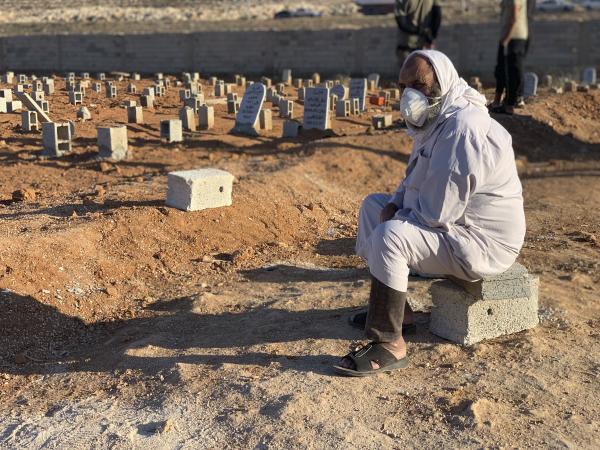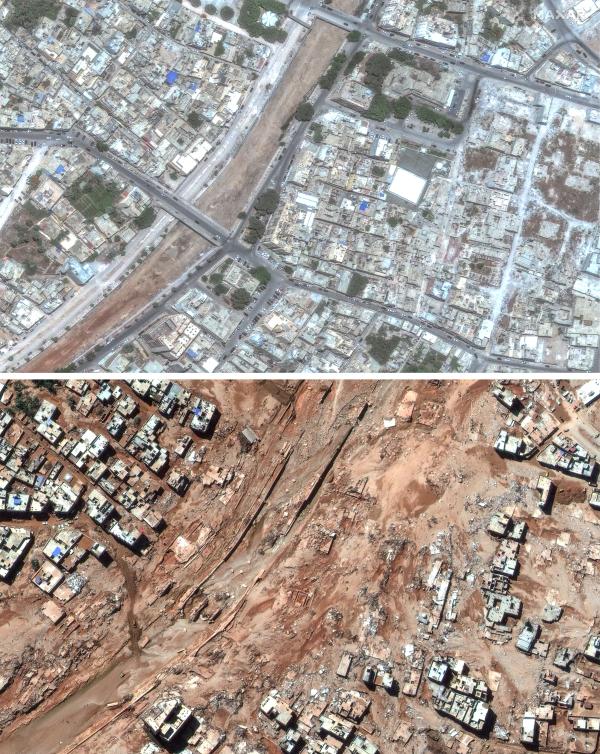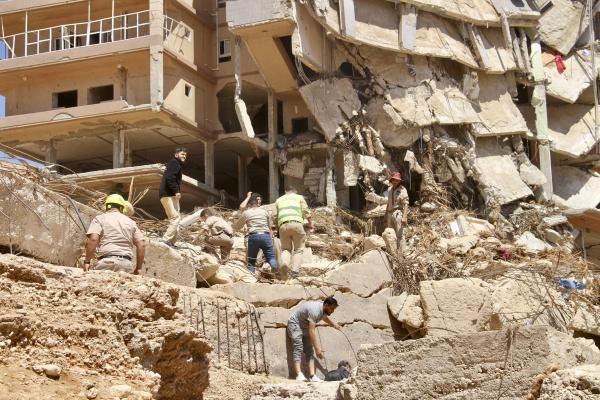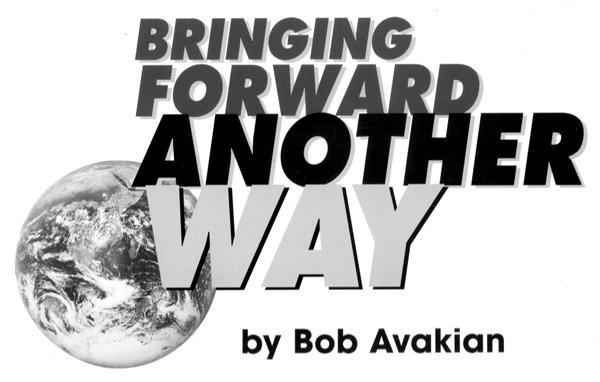Bob Avakian has written that one of three things that has “to happen in order for there to be real and lasting change for the better: People have to fully confront the actual history of this country and its role in the world up to today, and the terrible consequences of this.” (See “3 Things that have to happen in order for there to be real and lasting change for the better.”)
In that light, and in that spirit, “American Crime” is a regular feature of revcom.us. Each installment focuses on one of the 100 worst crimes committed by the U.S. rulers—out of countless bloody crimes they have carried out against people around the world, from the founding of the U.S. to the present day.
See all the articles in this series.

A grieving man sits by the graves of the flash flood victims in Derna, Libya, Friday, Sept. 15, 2023. The death toll in Libya's coastal city of Derna is over ten thousand. Photo: AP
Devastating Flooding Hits Eastern Libya
On the weekend of September 9-10, 2023, the powerful Mediterranean storm Daniel drenched eastern Libya with a record downpour. Sixteen inches of rain fell in 24 hours, streaming down through mountains and deserts into the dry riverbed running north through the coastal city of Derna, home to 100,000 people. The raging torrent overwhelmed two dams and flooded Derna. Buildings, homes, schools, mosques, even entire neighborhoods were carried out to sea by waves of mud and water. Bridges and roads were swept away. The city was split in half, at least 20 percent of it destroyed.

Aerial photos show the flooded neighborhood of Derna, Libya before (top) and after (bottom) the devastating flood unleashed by the collapse of dams outside the city. Photo: AP
By Wednesday night, September 13, the Libyan Red Crescent organization said the number of dead may be 10,000 or 11,000. The mayor of Derna said the number of dead could reach 20,000; at least 34,000 people were displaced from their homes. “We could never have imagined what we saw: corpses in the ocean, whole families wiped out, fathers and sons and brothers stacked on top of each other,” one resident said. “Whole buildings dragged into the water with their residents still inside.”
According to scientists, the “ferocious strength” of Storm Daniel “was powered by climate change.” Daniel drew enormous energy and greater amounts of water vapor from the Mediterranean’s extremely warm water, and this led to much heavier rainfall.
Yet since 1750, Libya has only been responsible for 0.13 percent of all global greenhouse gas emissions, which drive climate change, while the United States has been responsible for nearly 25 percent—192 times more! 1 This is a fact that has not been part of the major U.S. media’s coverage of this deadly catastrophe.

Searching for survivors in Derna, Libya, Wednesday, Sept.13, 2023. The collapse of two dams unleashed a massive flash flood that killed thousands of people. Photo: AP
The media has duly reported on Libya’s battered infrastructure and lack of preparation or warnings to the population before Daniel hit. For instance, Daniel’s power had demonstrated itself in Greece, Turkey and Bulgaria a week earlier, but people in Derna had not been clearly warned of its danger or evacuated. The secretary general of the World Meteorological Organization summed up, “We could have avoided most of the human casualties.” A 2021 report by the Libyan state audit bureau had found that funds allocated to maintain the two dams that collapsed and led to Derna’s catastrophic flooding had not even been used. And as of September 2023, at least two other dams in eastern Libya were in danger of collapse.


The media has also reported how Libya’s warring factions and fractured government have blocked efforts to maintain Libya’s infrastructure and functioning social and government services—such as its meteorological service.
But the U.S. media has refused to delve into how the imperialist domination of Libya, an oppressed Third World country, in general and the 2011 U.S.-led war and the ongoing actions of the U.S. and other powers in particular, have led to the needless and terrible loss of life in Derna.
This American Crime article is the story of that 2011 U.S.-led war and its devastating impact on Libya right up to today.
THE CRIME
In February 2011, in the context of the Arab Spring uprisings in neighboring Tunisia and Egypt, sections of Libyan society rose up against Muammar Qaddafi’s oppressive, 42-year-long rule. The Qaddafi regime responded by violently suppressing the protests.
In this context, at the insistence of the U.S., France, and Britain, the UN Security Council passed Resolution 1973, giving the UN authority to militarily intervene in Libya. The UN resolution called for a humanitarian effort to save the lives of pro-democracy protesters endangered by Qaddafi’s forces who were threatening to bomb their stronghold in Benghazi, the country’s second-largest city.
Within 48 hours, the U.S. and other NATO countries established a “no-fly zone” throughout Libya and started bombing Qaddafi’s forces. For the next seven months, 19 NATO countries carried out massive military operations throughout Libya. They deployed aircraft carriers with warplanes, amphibious warships, torpedo jets, surveillance planes, submarines, and U.S. missile-armed Predator drones. Though the bulk of the bombings and killings were carried out by the U.S., Britain, France, and Canada, at its peak the war involved 21 NATO ships and more than 250 aircraft of all types. Over 8,000 U.S. military personnel took part and U.S. aircraft bombed Libya 14,202 times. These aerial attacks included B-2 stealth bombers that were each armed with 16 2,000-pound bombs.


Tripoli, Libya; residential building damaged during seven months of U.S./NATO bombing of Libya in 2011. Photo: AP
NATO bombs killed Qaddafi’s forces, but they also took the lives of many civilians, including women and children. On May 14, one NATO bomb killed 11 religious leaders and wounded 50 others who had gathered for Friday prayers in Brega. On August 9, a NATO aerial bomb struck Libyan state TV, Al-Jamahiriya, killing three journalists and wounding several others. Ordinary Libyans were also killed, like Karima, her husband, and their children, Jomana, age two and Khaled, age seven months. Eight of their other family members were wounded.
The U.S./NATO forces declared Libya’s “liberation” in October 2011. Anti-Qaddafi militia had captured and killed Qaddafi, shattered the central government, and established a “National Transitional Council” (NTC).
While there had been an estimated 1,000 killed before the start of the NATO invasion, by October estimates were that 10,000 to 30,000 had died. That included soldiers and civilians killed by the UN-sanctioned war, and also victims of the large numbers of atrocities carried out by the militia backed by the U.S., Britain, and France which had carried out mass abductions, detentions, torture, and killings—500 in just a two-month period.
During this same period, African migrants and black Libyans were subjected to a racist campaign that included mass detention, lynchings, and other atrocities, justified by the claim they were mercenaries of Qaddafi’s regime.
The U.S. Permanent Representative to the UN called the toppling of Qaddafi’s regime a “model intervention.” And Britain declared to the UN in 2012, “Today, Tripoli and Benghazi are cities transformed. Where there was fear, now there is hope and an optimism and belief that is truly inspiring.”
In fact, in the years since the overthrow of Muammar Qaddafi’s regime, Libya has been plunged into a state of chaos, and the lives of millions of Libyans have been shattered.
The NTC was never able to consolidate authority over its rivals in other cities and the patchwork of hundreds of Islamist and tribal militias battling each other in the streets for power. Three years after the overthrow of Qaddafi, Libya had become a place of assassinations, kidnappings, blockades of oil refineries, and ISIS and other Islamist extremists setting up camps, with this instability spilling across Libya’s borders.
For the masses of Libyan people life has been a nightmare. The economy and public services have been decimated, including the public health system. In 2015, it was revealed that NATO forces had targeted civilian infrastructure, especially water supplies during their 2011 attacks, while blaming the damage on Qaddafi. A third of Libya’s people remain impoverished, and many do not have access to clean water or sewer systems and are forced to struggle to meet their basic needs and survive.
By 2016, it was estimated that nearly 2.44 million people—a third of Libya’s population—had been impacted by these reactionary conflicts. There are now shortages of food, water, and electricity. People often can’t get medicines, public services, or medical care—even though in the summer of 2015 the UN estimated that 2.5 million Libyans did not have any access to health care and some 400,000 needed food aid. This nightmare has driven nearly a half a million Libyans from their homes—forcing people to live in garages, public spaces, shelters, or unfinished buildings.
For years Libya’s location as the North African country closest to Europe made it a major hub for refugees, asylum seekers, and migrants from North Africa and the Middle East desperately trying to escape war, poverty and the impacts of global warming. In the first 10 months of 2017, most of the more than 160,000 people coming to Europe by sea had departed from Libya; and 2,772 died or went missing trying to cross. It was reported that nearly 350,000 migrants and asylum seekers remained in Libya. At this writing in September 2023, it’s estimated that there are now more than700,000 migrants in Libya—nearly 10 percent of the population.
The same NATO powers that attacked Libya in 2011 were now training and supporting Libya’s coast guard in its effort to capture migrants and asylum seekers in international waters and return them to Libya, where they would be exposed to physical abuse, including beatings, sexual violence, extortion, abduction, and forced labor. In May 2017, Al Jazeera reported, “Migrants are being sold in the market as a commodity. Selling human beings is becoming a trend among smugglers as the smuggling networks in Libya are becoming stronger and stronger.” In November, after revelations of alleged “slave auctions,” Rwanda offered to resettle 30,000 African “slaves” from Libya.
Amnesty International’s report “Libya 2017-2018” said, “Three rival governments and hundreds of militias and armed groups continued to compete for power and control over territory, lucrative trade routes and strategic military locations.... All sides to the conflict carried out indiscriminate attacks in heavily populated areas leading to deaths of civilians and unlawful killings.”
Today, Libya remains a battleground between reactionary forces and outside powers. The government is split in two—one faction is based in Tripoli in the west, the other in Benghazi and the east. As recently as 2020, they were waging all-out war against each other. Each one is backed by different (and shifting) groups of international powers and armed militias, each fighting to advance its own reactionary interests.2
Between 2015 to 2019, the U.S. and its allies carried out a large number of drone strikes and airstrikes against alleged ISIS forces and in support of the reactionary, Tripoli-based “Government of National Accord” faction they were backing. Today, Russia, Turkey, Egypt, the UAE, France, Italy and Qatar all continue to fuel the battle for power with money and weapons, fueling chaos and instability.3
The hell that is life in Libya in the wake of the 2011 U.S.-led invasion and the ongoing reactionary conflicts it unleashed has taken another leap, deeper into the abyss, with the September 2023 Storm Daniel.


Bringing Forward Another Way is an edited version of a talk by Bob Avakian to a group of Party supporters, in 2006. It is must reading for a serious understanding of what the U.S. "war on terror" is really about and how to bring forward a positive force in the world in opposition to both Western imperialism and Islamic Jihad.
THE CRIMINALS:
President Barack Obama: Took full credit for the war on Libya, the capture and murder of Qaddafi, and the destruction of the government. After Qaddafi was killed, Obama said, “Without putting a single U.S. service member on the ground, we achieved our objectives.”
Hillary Clinton: As secretary of state, Clinton played a key role in convincing Obama to join the British and the French who were pressing the UN to establish a “no fly zone” over Libya and start bombing. She argued the U.S. must not wait but should strike right away. When NTC forces captured, tortured, and murdered Qaddafi, Clinton laughed on TV, saying, “We came, we saw, he died.”
U.S. Ambassador to the United Nations Susan Rice, and U.S. aide on the UN Security Council Samantha Power: Both these officials, who claim to be champions of “human rights,” urged Obama to attack Libya.
U.S. Secretary of Defense Robert Gates and the U.S. military forces: Responsible for leading the military in achieving U.S. objectives in Libya, Gates said to the New York Times in 2016, “The fiction was maintained [that] ... the goal was limited to disabling Colonel Qaddafi’s command and control,” but he admitted, “I don’t think there was a day that passed that people didn’t hope he would be in one of those command and control centers.”
Leading NATO imperialist powers: Britain under David Cameron, France under Nicolas Sarkozy, Canada under Stephen Harper, and Italy under Silvio Berlusconi and their military commanders, pilots, and troops, especially Canada’s Lt. General Charles Bouchard, U.S. Admiral James Stavridis, and Lt. General Ralph Jodice who led the military assault on Libya called Operation United Protector.
All other NATO countries and allies (Belgium, Bulgaria, Denmark, Greece, Netherlands, Norway, Romania, Spain) as well as the United Arab League (Qatar, Jordan, United Arab Emirates) and Sweden—whose armed forces and politicians ganged up together in this assault on Libya. Many of these countries, as well as NATO countries France and Italy, continue to directly intervene and contend in Libya.
Ban-Ki Moon, UN General Secretary, and the full UN Security Council: The 10 members (U.S., Britain, Italy, Lebanon, Bosnia and Herzegovina, Columbia, Portugal, Nigeria, South Africa, France) who voted for Resolution 1973 that authorized the imperialists’ invasion of Libya with a cover of “humanitarian intervention”; and the five members (Brazil, China, Russia, Germany, India) who refused to use their veto powers to prevent it.
The reactionary Libyan ruling factions, linked to imperialist and regional powers, which are vying for dominance, as well as the predatory armed militias, all of whom have caused enormous chaos and suffering for the masses of people in Libya.

THE ALIBI:
Obama insisted his goal in Libya was not “regime change,” but a humanitarian intervention under the U.S. doctrine of “Responsibility to Protect.” Obama declared, “Left unchecked, we have every reason to believe that Qaddafi would commit atrocities against his people. Many thousands could die. A humanitarian crisis would ensue. The entire region could be destabilized, endangering many of our allies and partners. The calls of the Libyan people for help would go unanswered. The democratic values that we stand for would be overrun. Moreover, the words of the international community would be rendered hollow.”
THE ACTUAL MOTIVE:
In the name of protecting Libyan civilians, the U.S. and its NATO allies seized on the conflict in Libya to wage a war for regime change. There was no evidence that Qaddafi was preparing to massacre civilians. For the imperialists, the Libyan uprising presented both the need and opportunity to remove Qaddafi from power and install a neocolonial regime that would be a more pliant tool to advance their interests in a region where Western imperialism was—and is—under all kinds of pressure, and faces all kinds of challenges from rival imperialists, as well as ISIS.
Libya is Africa’s fourth-largest country, strategically located in North Africa and neighboring Egypt, Tunisia, and Algeria. It is a gateway to the Mediterranean Sea, Red Sea, and Indian Ocean routes from Africa to Europe and the whole Middle East. With a small population of about six million and the largest proven oil reserves of any African country, along with gold reserves, Libya has been one of the richest countries in Africa. And it has supplied a large share of Europe’s oil needs.
For many years, Qaddafi was a thorn in the side of imperialism, especially the U.S. Despite his anti-imperialist/Pan Africanist rhetoric, Qaddafi presided over an oppressive social and economic order, and his program of enacting certain economic and social reforms was based on expanding Libya’s oil-based economy.
When he allied Libya with the then-imperialist Soviet Union in the early 1980s, the U.S. demonized him as a “strongman despot” and Reagan tried to have him assassinated. In 2004, Qaddafi announced that he was giving up various nuclear and other weapons programs. The U.S. took Libya off its list of “terrorist states,” and Qaddafi became an ally in the U.S. “war against terrorism,” which in reality was a war for empire.
However, Qaddafi continued to build ties with Russia and China, offering them lucrative oil deals and granting access to the port of Benghazi for the Russian fleet. With the 2011 Arab Spring spreading, the U.S. and its NATO allies saw the opportunity to replace his regime with one more directly under their control in such a valuable and strategic part of the world, as well as to intervene and impact the course of the Arab Spring overall.
Sources:
Revolution Interviews Raymond Lotta: The Events in Libya in Historical Perspective... Muammar Qaddafi in Class Perspective... The Question of Leadership in Communist Perspective, revcom.us, March 8, 2011
The Fall of the Qaddafi Regime in Libya...and the Hand of the U.S. and NATO, revcom.us, August 28, 2011
The 2011 U.S.-NATO War Helped Turn Libya Into Hell on Earth: Now the Imperialists Are Preparing to Wage War Again, revcom.us, February 1, 2016
Casualties of 2011 Libyan Civil War, Wikipedia
2011 military intervention in Libya, Wikipedia
In Strikes on Libya by NATO, an Unspoken Civilian Toll, C.J. Chivers and Eric Schmitt, New York Times, December 17, 2011
If Libyan war was about saving lives, it was a catastrophic failure, Seumas Milne, Guardian, October 26, 2011
On His Way Out the Door, Obama Bombs Libya One Last Time, Common Dreams, January 19, 2017
Blowback: How the Bombing of Libya in 2011 Led to Terror in Britain, Mehdi Hasan, The Intercept, February 26, 2018
Libya: The REAL U.S. Drone War, Spencer Ackerman, Wired, October 20, 2011
Update Sources:
Aging dams and missed warnings: A lethal mix of factors caused Africa’s deadliest flood disaster, CNN, September 15, 2023
Why the media aren’t telling the whole story of Libya’s floods, Declassified UK, September 15, 2023
Climate change and crumbling infrastructure made Libya’s devastating floods worse, scientists say, Euronews Green with AP, September 13, 2023
How Libya’s chaos left its people vulnerable to deadly flooding, Associated Press, September 13, 2023
From Factionalism to Foreign Interference: Libya’s Conflict Remains Frozen, U.S. Institute of Peace, November 3, 2022
Access to Derna Is Limited as Libyan Authorities Struggle in Flood’s Aftermath New York Times, September 15, 2023
After Libya Floods, a Chaotic Scramble for Rescuers, New York Times, September 14, 2023
What We Know About the Deadly Floods in Libya, New York Times, September 13, 2023
Cries of ‘Save Us, Save Us’ as Homes Fill With Water, New York Times, September 13, 2023
